The Marshall Spectator

In This Issue:
From The Skittles Room
In Memoriam: FM John Curdo
FM Paul Whitehead: Chess at the Top
Across the Table
Chess Toons
En Passant
Problem of the Week
Editor's Note

Welcome back dear readers to this edition of the Marshall Chess Club's fortnightly bulletin, The Marshall Spectator.
If you like The Marshall Spectator, you'll love the Chess Room Newsletter from the Mechanic's Institute. Many of our staff and board members regularly enjoy it - in particular the column by FM Paul Whitehead as well as the annotated games and excellent analysis. We encourage you to subscribe! We think you'll enjoy it as much as we do.
The last two weeks has seen a surfeit of rated events at our own historic club here at twenty three west tenth street.
The Thursday Open ended on October 20 with 13 players registered and one clear winner. Ethan Kozower scored 5 out of 6 and earned the $125 clear first prize. There was a two-way tie between George P Berg and Alan Frank McMichael who scored 4 points and earned $68.75, while John J Brendel and Paul Defusco finished with 3.5 points and made $18.75 each for their efforts.
The Boris Privman Action on October 20 had 21 registrants. There were two players who finished with 3.5 out of 4: IM Michael Song and Kiren Nasta won $90 for their efforts. Four players finished with 3 points. Vladimir Bugayev, Max Mottola, and Elias Stern-Rodriguez earned $20 each while Andrew Colwell took home the class prize of $60.
The Under 2000 Morning Action on October 22 had two perfect scores. Dominic Paragua and Christopher Williams finished with a perfect 3 out of 3 and earned $78 for their performance, while James Margolis won the class prize or $78, scoring 2.5 out of 3.
The Monthly Under 2400 on October 23 had an eye-popping 51 players registered and a 4-way tie for first place: Rochelle Ballantyne, Pardhav Chakka, James Marsh and Linxi Zhu all scored 4 out of 5, winning $234.75 for their efforts. Nico Alvarado-Yoshida and Eden You both scored an impressive 3.5 out of 4, winning a class prize of $94 each, while there was a large 5-way tie of other players who also scored 3.5: Anthony Levin, George Berg, Aleksandr Gutnik, Ethan Kozower and Suvan Baranwal all took home $25 for their efforts.
The Rated Beginner Open on October 23 had an even 30 players, with Eric Niyazov and Nicholas Pipitone scoring a perfect 3 out of 3 and taking home $130.50 each. Another impressive result in this tournament was made by Dylan James Chan-Schlauraff who gained an impressive 155 rating points. In this same event, Dennis Yidong Chen also gained an incredible 138 rating points!
The Monday Under 1800 concluded on October 24, with 12 players participating in the event and only 1 clear winner. It was Matthew Slesinski scoring a perfect 6 out of 6 and winning $125 for his effort. Jesse Sun finished in clear second with 5 out of 6 points and earning $75 while Joseph De Villa finished in 3rd place taking home $50. Christopher He also had a great event, winning the class prize of $50 with 3 out of 6.
The FIDE Monday concluded on October 24. This remains one of our most popular weekly events, drawing 27 participants in this most recent edition. Richard Herbst scored an impressive 5 points out of 6 rounds and won the first place prize of $288. There was a two-way tie between Gianluca Pane and our club’s president Sarathi Ray, who both scored 4.5 out of 6 points and won $168 for their performance. Daniel Johnston, Max Chang and Christopher Seck scored 4 out of 6 and earned $32 each for their effort.
The Boris Privman Action on October 27 had sixteen players registered and a clear winner. IM Michael Song finished with 3.5 out of 4 points, earning the $78 first place prize. GM Michael Rohde and Vladimir Bugayev finished with 3 points each and took home $39 for their performance, as did Alec Choi who won the class prize with 2.5 out of 4.
The Friday Blitz on October 28 was won by IM Michael Song who finished ahead of a field of 32 players with a nearly perfect 8 points out of 9 rounds. Zachary Tanenbaum finished with 6.5 points, earning $89 for his performance. FM Andrey Krasnov, Roman Malyshev, and IM Justin Sarkar each finished with 6 points and won $29.33, while Daniel Wang also scored 6 points winning the class prize of $44. Giorgi Sukhiashvili also won a $44 class prize with a 5 out of 9 performance.
The Saturday Game 50 Open on October 29 was packed with 46 players registered and a three-way tie for first between IM Justin Sarkar, Vladimir Bugayev and Luc Hoffman each scoring 3.5 out of 4 and winning $146.67 for their efforts. There was also a 6-way tie among Connor Junda Wang, Morgan Mairaj, Aaron Kudryavsky, Mansurov Yusuf, Harper Wallace and Christian Higgins who finished with 3 out of 4 each and earned $22 for their performance.
The Saturday Game 50 Under 1800 on October 29 had 19 players registered and two of them sharing the top spot. Justin Scott Rosales and Kiaan Javeri finished with 3.5 out of 4 points and earned $90 for their performance, while Zoe Wong earned $54 for her 3 out of 4 score. Christian Higgins also had an impressive result in this event, gaining an amazing 135 rating points.
The Sunday Game 50 Open on October 30 was won by the former club champion, GM Michael Rohde who scored a perfect 4 out of 4 and earned $168 for his efforts. NM Bryan Weisz, Kylan Huang and Dominic Paragua all scored 3 points and earned $37.33. Wyatt Wong won the class prize of $84 for his 3 out of 4 score. Another impressive result in this event was made by Roman Rubinstein Mash, who gained a whopping 146 rating points in this event.
The Sunday Game 50 Under 1600 on October 30 had 23 players registered. There were two players who finished with a perfect 4 out of 4 score: Christopher He and Dzmitry Kharchykau both won $110 for their perfect performance, while Dena Wang won the class prize, taking home $66 and scoring 3 out of 4. Dena Wang also gained an incredible 144 rating points in this tournament! What's more, Dena is the reigning US Under 8 All-Girls Champion, currently listed as one of the top girls under 7 years old in the country and will be featured in this month's Chess Life Magazine!
The Rated Beginner Open on October 30 had 27 players registered and a 3-way tie for first place, with Mrinal Vibhav Arun, Ziva Marcal and Nick Eames scoring a perfect 3 out of 3 points and earning $75 each for their perfect performance.
To see these and all other recent results, click here. You can see who has gained the most rating points in our recent events by clicking here.
Coming up on Friday November 11, we will once again host a three round women and girls only tournament. We are thrilled to continue this event and look forward to a large turnout. All details are available on our calendar and registration for the event will be available on our registration page in the coming days.
On Tuesdays, Chess Instructor Tamar Chanadiri teaches a chess class geared for adult beginner chess players from 6:30pm-8:00pm. In addition, Tamar Chanadiri's Saturday morning scholastic class will continue each Saturday morning in person at our club. Full details for both events can be found on our calendar.
A panel discussion on cheating and ethics will be held on 11/22, featuring leading experts in the field Dr. Kenneth Regan, Mr. Randy Bauer and Mr. Vlado Drkulec. Please check our calendar for more details about this and all of our upcoming events.
We were thrilled to see so many members in costume over the Halloween weekend and gave out some prizes to the "best dressed."
The Phantom of the Opera stopped by to play a few rounds in the Sunday Game 50 event, and even the club itself also seemed to be a bit spookier than normal.
Happy Halloween!
Finally, if you haven't yet, be sure to join our new Chess.com Puzzle Leaderboard for Marshall Chess Club Members. Register for the Chess.com Leaderboard here and your stats will appear automatically. Currently, our top 5 are as follows: Zachary Tanenbaum (81!), Kole Moses (67), William Safranek (64), Jack Gore (62), Robert Leonard (55).
— Greg Keener, Editor of the Spectator
In Memoriam: FM John Curdo
I was saddened to hear the news of the passing of chess legend John Curdo on Sept. 30. Growing up and playing chess in New England, it was impossible to not have played or been affected by John who was a constant presence within the chess community in the northeast. I knew John only as a teenager and was not particularly close to him, however, he had an important impact on me and my chess career, as well as many others, and I remember him for being a stalwart of New England Chess.
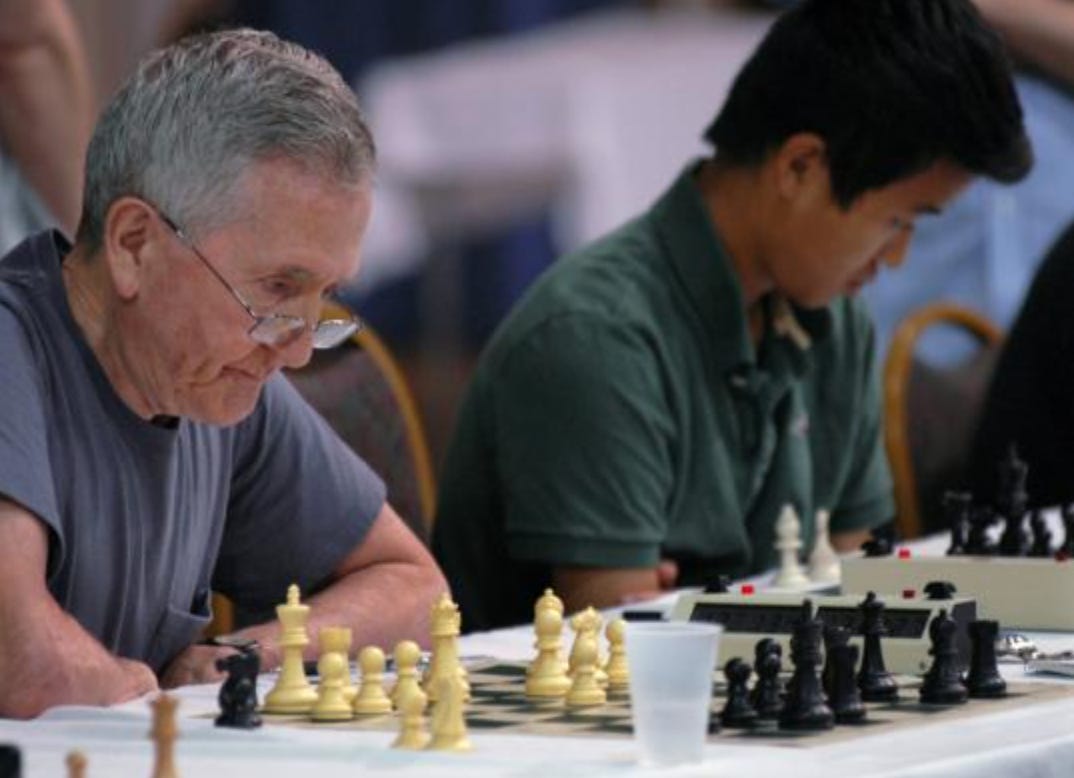
I was surprised to learn that a fellow Marshall Chess Club member who in my opinion knows a fair bit about American chess had never heard of John Curdo. When I tried to explain just how important of a figure John was to me - I reached for an analog - a chess figure that everyone reading this newsletter will be familiar with - I said "He was like Jay Bonin." I feel that comparison in itself explains more than I could ever write, and I definitely would claim to call John Curdo the “Iron-Man” of New England Chess.
John was a strong FM, peaking at 2516 USCF, and was rumored to have won more chess tournaments in the US than any other player. While USCF records do not date back to include most of his career as a player, a quick glance at recent records shows that Curdo won over 1000 events - a staggering number - and was still active up until his last tournament in 2020. What did this statistic mean for me as a scholastic player growing up in New England? I did not play a single open tournament in Connecticut, Massachusetts, or Vermont that did not have John Curdo as a registered participant. What’s more, he was often seeded 1st.
Curdo’s activity as a tournament player meant that he was very likely the first chess master you would have the opportunity of playing if you lived in New England. My first game against him as a 13 year-old, when I was about 1800 USCF, captures his style.
John Curdo vs Alex Fikiet
(Play through the game here.)
1. e4 e5 2. Nf3 Nc6 3. Nc3 The Four Knights-- A Curdo speciality. In general, Curdo favored offbeat and less theoretical lines. Particularly, he was considered an expert in lines in the Alapin Sicilian, Dutch Defense, and Belgrade gambit, which we will see here.
3... Nf6 4. d4 exd4 5. Nd5
As a naive child, I had not thought to consider what Curdo had played before, and this move (the Belgrade Gambit) utterly surprised me. Had only database software been more prevalent during Curdo's time, I'm sure he would have had over a hundred games in this line.
5... Nxe4 I'm a big dummy for going into these complications with no knowledge.
6. Qe2 f5 7. Ng5 Clearing the d3 square for the black knight is the only move here. It scores pretty well for Black at the master level, but of course it's a maze of complications. My move simply gives White a very pleasant advantage and a nice attack.
7... Be7?! 8. Nxe4 fxe4 9. Qxe4 O-O 10. Bd3
I realized now I had to create big weaknesses on the kingside, and I am lagging in development.
10... g6 11. Bh6 Rf7 12. h4
And h5 will unleash a devastating attack if not prevented.
12... d6 My one hope was to answer h5 with Bf5, displacing the queen and trading some pieces. I remember thinking I was okay here, but I only considered h5, and literally no other moves...
13. Bc4! This is obviously a strong move, but I did not consider a piece moving twice (d3, then c4) in the opening so quickly. Obviously a master can break opening principles, and once the d3 bishop had created dark square weaknesses, its switches to do lethal damage on the a3-g8 diagonal.
13... Bf5 14. Nxe7+ Qxe7 15. Qxe7 Nxe7 16. Bxf7+ Kxf7 White is simply up an exchange, and Curdo's master-level technique was no match for little old me. The rest goes without comment.
17. O-O-O Nc6 18. f3 Re8 19. g4 Bd7 20. h5 gxh5 21. Rxh5 Re2 22. Bd2 Ne5 23. Rxh7+ Kf8 24. Rdh1 I resigned, fearing the powerful rooks and passed connected pawns on the kingside. I am busted.
After this encounter, I would go on to play Curdo a total of 16 times. As a chess player, he was a symbolic figure who motivated me to work harder towards my own chess improvement. As I got stronger, he became more and more of an “end-boss” in the tournaments I would play. I still remember the first time I won a game against him - a very tense tactical struggle in the Dutch defense. I cannot say we spoke more than a couple words with each other, but as any serious chess player can attest to, playing chess develops a connection that words cannot accomplish. Chess can be a battle of wills - and Curdo’s was one of the strongest I encountered over the board. The mark that he left on chess was unique and noteworthy in equal measure, making him genuinely my first chess role-model.
I leave you with one of his notated games that made an impact on me. It’s a sparkling win against GM Sergey Kudrin, who frequently attended marquee Marshall events in the past:
FM John Curdo vs GM Sergei Kudrin
(Play through the game here.)
1. e4 c5 2. Nf3 g6?! Fairly typical. Without getting too detailed, I would consider this as a way to avoid Curdo's preferred c3 lines.
3. d4 cxd4 4. Qxd4!? spicing it up.
4... Nf6 5. Bb5?! Some more spice - trying to prevent d6.
5... a6 6. Ba4 b5 7. Bb3 Nc6 8. Qd3 A non-standard position typical of Curdo's games.
8... Bg7 9. O-O O-O 10. Nc3 d6 11. Bg5 Bb7 12. Rfe1 Develop, and centralize.
12... Na5 13. Nd5 Nxd5 14. exd5 This exchange on d5 was a favorable strategic transformation. The dragon pawn structure (d6 through h7 pawns) is typically weak on e7, and the half-open file makes targeting it easier. What is more, the d5 pawn makes Black's light-squared bishop "bite granite."
14... Re8 Defending said weakness
15. Re2 preparing to double rooks, targeting said weakness.
15... h6 16. Bh4 g5 Black takes drastic measures to prevent White's bishop from targeting e7. While the computer doesn't mind this, I do from a human standpoint. The opening of the kingside is risky, especially against Curdo, who I consider an excellent attacker and tactician.
17. Bg3 Bxb2 18. Rae1 Who cares about a pawn!? White's pieces are all mobilized.
18... Bf6?! 19. h4 A pawn lever, trying to open more files and diagonals.
19... Qd7?! 20. hxg5 hxg5 21. Re6!!
This move leaves a huge impression on me. the d5-e6 constellation acts as a blockade, prevent black pieces from easily moving over to defend the kingside.
21... Nxb3 21... fxe6 is impossible: 22. Qg6+ Bg7 (22... Kh8 23. Nxg5 Bxg5 24. Qh5+ Kg7 25. Qxg5+ Kh8 26. Re4) (22... Kf8 23. dxe6) 23. Nxg5 e5 24. Qf7+ Kh8 25. Re4 And White mates. Black must tolerate the intrusive white rook, but it is quite annoying.
22. cxb3 Kg7 23. Nd4? This move is logical. The rook is still immune, and the knight aims for f5. But according to the engine, a slight falter: (23. Nxg5!! Continues the attack in brilliant style. For instance 23... Rh8 (23... Bxg5 24. Qf5 And White's attack is unstoppable. It is essentially White's rooks, bishop and queen vs. Black's bishop, as all the other pieces are blocked from defending. A sample line: 24... Bf6 (24... f6 25. f4 Bh6 26. Bh4 Bxd5 27. Bxf6+ exf6 28. Qxf6+ Kg8 29. Qg6+ Bg7 30. Rxe8+ and it's lights out.
23... fxe6? Black could have gotten away with Bxd5, although I can understand a human not playing in this way. 23... Bxd5 24. Nf5+ Kh8 25. Rxf6 (25. Qxd5 fxe6 26. Rxe6) White is looking active and will have a persistent attack.
24. Nxe6+ Kh6?? Black actually needed to give up their queen, with some compensation and they aren't getting mated! (24... Qxe6 25. dxe6 Rac8 26. Qe3 Rc5 27. Rc1 Rxc1+ 28. Qxc1 Rc8 29. Qe3 Bd5 30. Qa7 Rc6 31. Qd7)
25. f4 A calm move. Down a rook, Curdo just tries to open more lines, with a sneaky idea of bringing other pieces into play.
25... g4? Trying to keep things closed.
26. Kf2!! 1-0 White wins. King moves are always a fun way to end a game. The rook joins in on h1 and the mating attack is unstoppable. A powerful sacrificial attack by Curdo against a strong grandmaster.
— NM Alex Fikiet, Spectator Columnist and Marshall Chess Club Member
FM Paul Whitehead
Hans Niemann: Chess at the Top
“Money Changes Everything” – The Brains
By now we are all familiar with the scandal engulfing the chess world, boiled down to this: lame-duck World Champion Magnus Carlsen loses a game in the Sinquefield Cup to 19- year-old American up-start GM Hans Niemann. He then withdraws from the tournament, at the same time making a vague insinuation that Niemann has cheated. A couple of weeks later in the online Julius Baer Generation Cup, Carlsen loses yet another game to Hans, resigning before playing his 2nd move. Shortly afterwards he makes a statement on social media, asserting that Hans had cheated during their encounter at the Sinqufield Cup – and offers not a single shred of evidence.
I want to offer my own opinion, based on long experience in the chess world plus my own interactions with Hans when he was an up-and-coming player at the Mechanics’ Institute.
It is not an easy path to the top of the chess world. It takes great fighting spirit and singleminded determination. Magnus Carlsen, like every other World Champion before him, has demonstrated those qualities. Other top players I have observed, like GM Walter Browne (one of Hans’ early coaches), manifest that desire to win in an almost visceral and physical way.
I have no doubt whatsoever that the will to win (and not to lose!) can cloud a chess players moral compass. Ashamedly, I remember engaging in fisticuffs with my own brother over a disputed game.
With that said, I’m curious what the reader might think of the following example. Captured on video, Carlsen attempts to take a move back against GM Alexandra Kosteniuk in the 2009 World Blitz Championship, and then leaves the table without a word or a handshake: https://www.youtube.com/watch?v=WeyXKTVYenA&t=161s
If this was not an attempted cheat, then I don’t know what is.
Perhaps even more damning is the following video, Carlsen’s own live-stream of the Lichess Titled Arena in December 2021. The World Champion clearly takes the advice of GM David Howell to trap GM Daniel Naroditsky’s queen. I understand the tournament had a 1st place of $500. The critical moment is at the 1:44:00 mark: https://www.youtube.com/watch?v=CRdrf1Ny3x8
I am not trying to throw just Magnus Carlsen under the bus here. Both of these videos show very typical displays of fighting spirit. Sadly, they also display not particularly rare examples of un-sportsmanlike behavior.
For the World Champion to accuse Niemann of what he himself is clearly guilty of is, in my opinion, just flat out wrong. If Niemann has cheated, then so has Carlsen. And many, many others.
Thirty years ago (and more) it was a common sight to see chess masters and grandmasters walking the hallways together, whispering in each other’s ears. I don’t believe the majority of players were outright cheating per se, but innocent questions or statements such as: “What do you think of my position?” or “Maybe it’s time to go home!” accompanied by frowns, raised eyebrows, coughing, laughing, et cetera, were quite common. Of course, this is different information than one can get nowadays. After all, a grandmaster is only human, and their suggestions and advice will only take you so far.
But Stockfish is a God.
Nowadays the top players are electronically frisked, and their trips to the bathroom are monitored - all under the smoky pall of large prize funds, large appearance fees, and generous corporate sponsorship.
While the top players and streamers, and the private interests that sponsor them (purporting to speak for the regular player), wring their hands worrying over the “integrity of the game” and the “existential threat” posed by cheaters, they are living in a chess world unimaginable only 30-40 years ago.
Back then, top players might have lived out of their cars or crashed on a friend’s couch, all the while waiting for a few paltry bucks from their chess federation or a miserable cash prize to pay their expenses. Chess lacked the glitz that corporate sponsorship and lots of money can buy: the glamorous world of The Queen’s Gambit, trash-talking streamers angling for a date with one of the Botez sisters, or better yet: the chance to be rich and/or the subject of world-wide attention.
Chess at the top looks, sounds, and tastes very different now than it did not so long ago. The players are younger, have nice haircuts, and pay respect (if not outright homage) to their master, World Champion Magnus Carlsen. It looks quite cozy from the outside: for almost ten years now, the same 15–20 players have competed against each other over and over again in countless tournaments, over the board and online. Rarely are outsiders permitted into this precious circle, which helps to keep their ratings inflated just enough to keep the invites and appearance fees coming and the sponsorships rolling in.
But cracks are starting to appear.
Almost all of the top players lost rating points at the recent Olympiad in Chennai, where they had to compete with lower rated players.
A younger generation is muscling in, in the shape of players like Hans Niemann, India’s Dommaraju Gukesh, and Nodirbek Abdusattorov from Uzbekistan. The latter became the World Rapid Champion earlier this year, defeating not only Carlsen, but Carlsen’s two most recent World Champion challengers, Fabiano Caruana and Ian Nepomniachtchi.
The young may also seem to lack the “proper respect,” which leads us back to what I see as the whole crux of this sorry Carlsen/Niemann affair.
Right now, with the lack of any evidence that Niemann cheated in that over-the-board game against Carlsen, I think the only conclusion we can reach is the one staring us all in the face: Hans Niemann beat Magnus Carlsen fair and square at the Sinquefield Cup.
I believe Hans has gotten under Magnus’ skin big-time, and, as is well documented here and elsewhere, Magnus hates losing. And to what extent, we are just now finding out. With Carlsen also abdicating the World Championship, I am reminded somewhat of an angry child that destroys his own sandcastle when told that it’s time to leave the beach.
Hans Niemann played a lot at the Mechanics’ Institute as a youngster (11-12 years old in 2013 and 2014), and his progress was meteoric. As I outlined in our last newsletter, his rating jumping from 1200 to 2200 in just under two years.
I myself played Hans a bunch of times, and his father recently sent me a video of Hans and I battling it out in a blitz game at the Mechanics’ Institute. I am totally winning for ages and ages, and his only hope is that I will lose on time. Hans hangs in there though, crying “Flag, flag, flag!” over and over. Both of us are enjoying the contest immensely… and I lose on time before I can mate him. His joy at winning is a sight to see.
Not everyone appreciated Han’s brash and cheeky demeanor. It was either IM John Donaldson or I who (affectionately) started calling him “Niemann the Demon,” but there were (and are still) players at the club who, perhaps, have forgotten what it was like to have been young once.
When I see Hans in those post-game interviews at the Sinquefield Cup, I feel I am watching exactly the same person that I knew back then: a person with a great love for chess, supremely confident in his abilities, and with respect for no one.
A stone-cold chess killer.
Hans acts in a rough and tumble manner that surprises us nowadays, and harkens back to earlier times - perhaps strongly influenced by older coaches like GMs Walter Browne, Max Dlugy, and IM John Grefe. These are no-nonsense and worldly fellows, and Hans’ development was tempered in steel.
I think the time has passed, if it ever really existed, when chess could lay claim to completely fair-play. Ruy Lopez de Segura (c.1530 - c.1580) a founding father of modern chess and a Catholic priest, advised his students to “place the board such that the light shines in your opponent’s eyes.”
Behind the brouhaha surrounding Carlsen and Niemann, there are other factors and interests playing out. As we follow chess celebrities, minor and major (because that is what they are now) we should also follow the money. Is it a coincidence that Niemann was banned anew from chess.com whilst the Play Magnus Group was acquired by that selfsame chess.com? I find it fascinating to see who is lining up to defend Carlsen’s accusations, and why.
There will always be attempts to cheat at over-the-board chess – some have been caught, others not. With the money pouring in, attempts to cheat will not stop, ever. Chess has entered the world of all other sports and games where these problems exist, whether it’s baseball or poker.
The online world thrived like nobody’s business during the pandemic: perhaps the real “existential threat” to wealthy streamers and online platforms is not cheaters – it’s the return to over-the-board play.
The chess world at the top has waited a long time for this moment – they’ve made it. They have world-wide attention, and they are rolling in the dough. In a sense they have gotten what they wished for, yet in another sense they are paying the price for those wishes coming true.
But back here, for the rest of us in the clubs, in our homes and schools, I believe chess will thrive and continue to be enjoyed for the skillful, interesting, and fascinating game that it is - untainted by money and enjoyed for its own sake.
The same way Hans and I enjoyed playing together, not so very long ago.
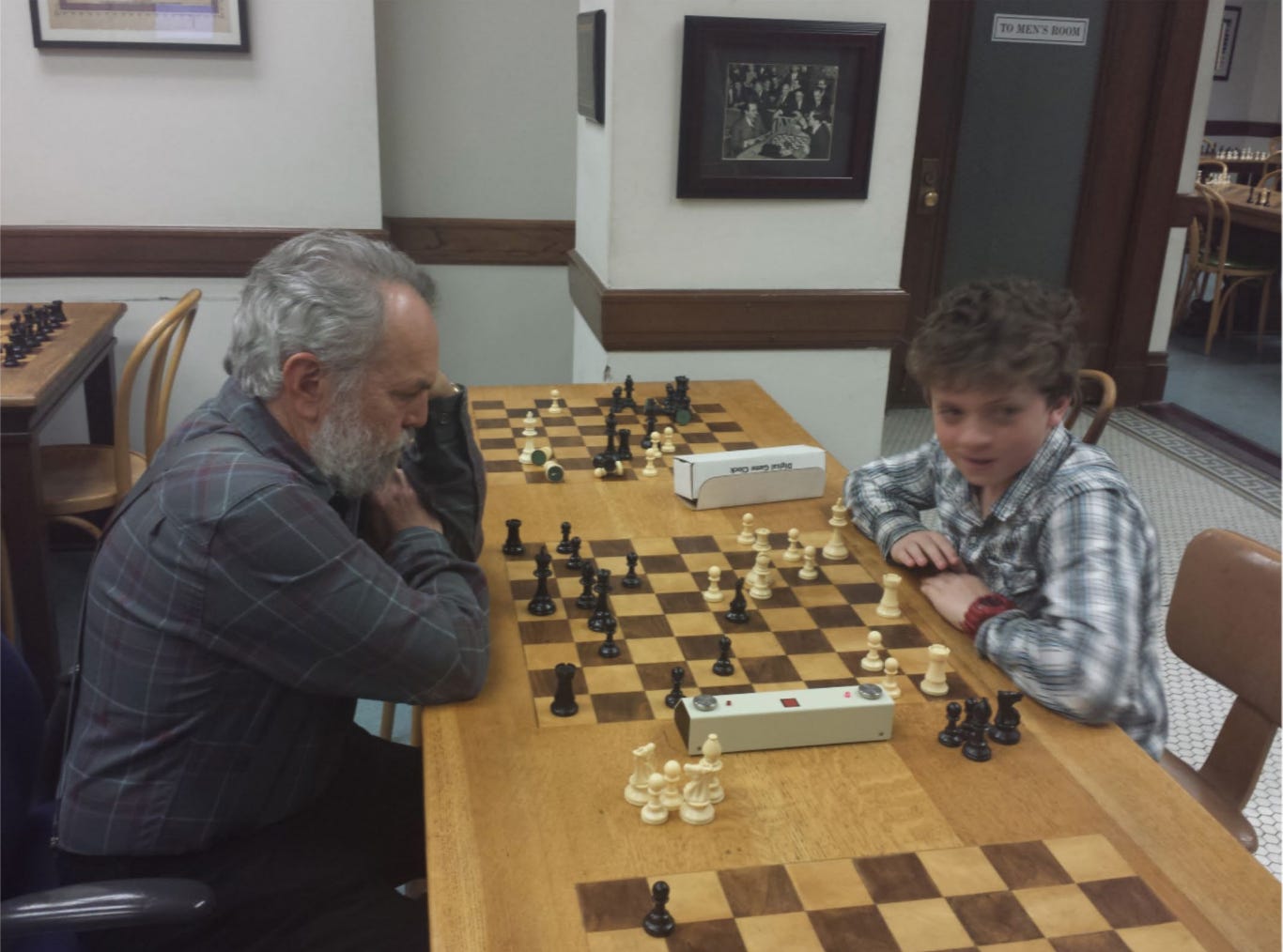
Hans Niemann playing blitz with GM James Tarjan at the Memorial for IM John Grefe at the MI in 2014. Photo by Elliott Winslow.
This article was reprinted with permission of the author and the Mechanics Institute Chess Room.
— FM Paul Whitehead, Mechanics Institute Chess Room Newsletter Columnist
Across The Table
When did you start playing chess and how did you learn?
I didn’t learn chess until I was in eighth grade (late bloomer by today’s standards). This was in the year 1991 and I’m not even sure who taught me but I think my older sister was the first one who taught me and it was reinforced by my father who also knew the rules of chess. But neither of them were skilled players. My middle school didn’t have a chess club so I would go to the high school’s chess club after school once a week and to sheepishly play with the high school students. Incidentally, the following year Bobby Fischer played Boris Spassky in their exhibition match in 1992 and I still vividly remember anxiously waiting for the newspaper every day so I could find their game notation in the sports section and clip it out with scissors to go over it. I remember it felt like every game was a Ruy Lopez and I never understood any of the moves.

George Wang pictured right with IM John Donaldson pictured left.
How long have you been coming to the club?
I started coming to the Marshall since about 2010. I had heard about the legendary Marshall Chess Club since my high school days growing up in St Louis, MO. Back in the 1990’s there were almost no chess players in St Louis and the only place people ever played were 5-10 people meeting up in cafes or churches, very informal chess gatherings. So it was always my dream to come play at Marshall ever since I was a teenager. And now that I am permanently living here in NYC, they suddenly opened up that gigantic chess club in St Louis – I always thought that was very ironic.
What’s your favorite opening trap?
I generally hate all opening traps since I’m usually on the wrong side of them. The only time I was on the winning side of a trap was in a game I played at Washington Square Park back about ten years ago, the Alekhine Defense opening trap:
1.e4 Nf6 2.e5 Nd5 3.Nf3 d6 4.Bc4 Nb6 5.Bxf7+ Kxf7 6.Ng5+ Kg8 7.Qf3 Qe8 8.e6 h6 9.Qf7+ Qxf7 10.exf7# 1–0
(Would only advise this trap for informal or blitz games.)
Who is your favorite chess player?
Robert J. Fischer….hands down. Levon Aronian and Alexander Grischuk are maybe a tie for second. :)
Any great game you’ve played at the Marshall you’d like to share?
This was an old game I played at the weekly Marshall U2000, where I think I may have made the least amount of mistakes. It was also the most positional game I have ever won as well, a style that I am still not use to regularly playing. But I hope you enjoy.
White: George K. Wang, 1646
Black: Roger C. Smith, 1960
Marshall Wednesday U2000, 2/4/2015
(Play through the game here.)
1.e4 c6 2.d4 d5 3.Nd2 dxe4 4.Nxe4 Nf6 5.Nxf6+ exf6 6.Bc4 Be7 7.Ne2 0–0 8.0–0 Bg4 9.c3 I later learned that the odd looking 9.f3 was probably the best continuation here.
9...Nd7 10.Qd3 Back in those days I was much more tactical and getting my queen out was my style.
10...Nb6 11.Bb3 Bh5?! Perhaps black’s first inaccuracy. It is clear he was trying for Bg6 to counter any ideas of me playing Bc2 with kingside pressure.
12.Nf4 Negating his plan immediately.
12...Bg4 13.h3 Bc8 An odd move but not many other squares were better, he later told me he avoided Bd7 hoping he could save it for Nd7 next.
14.Nh5 My knight here was to provoke one move only…
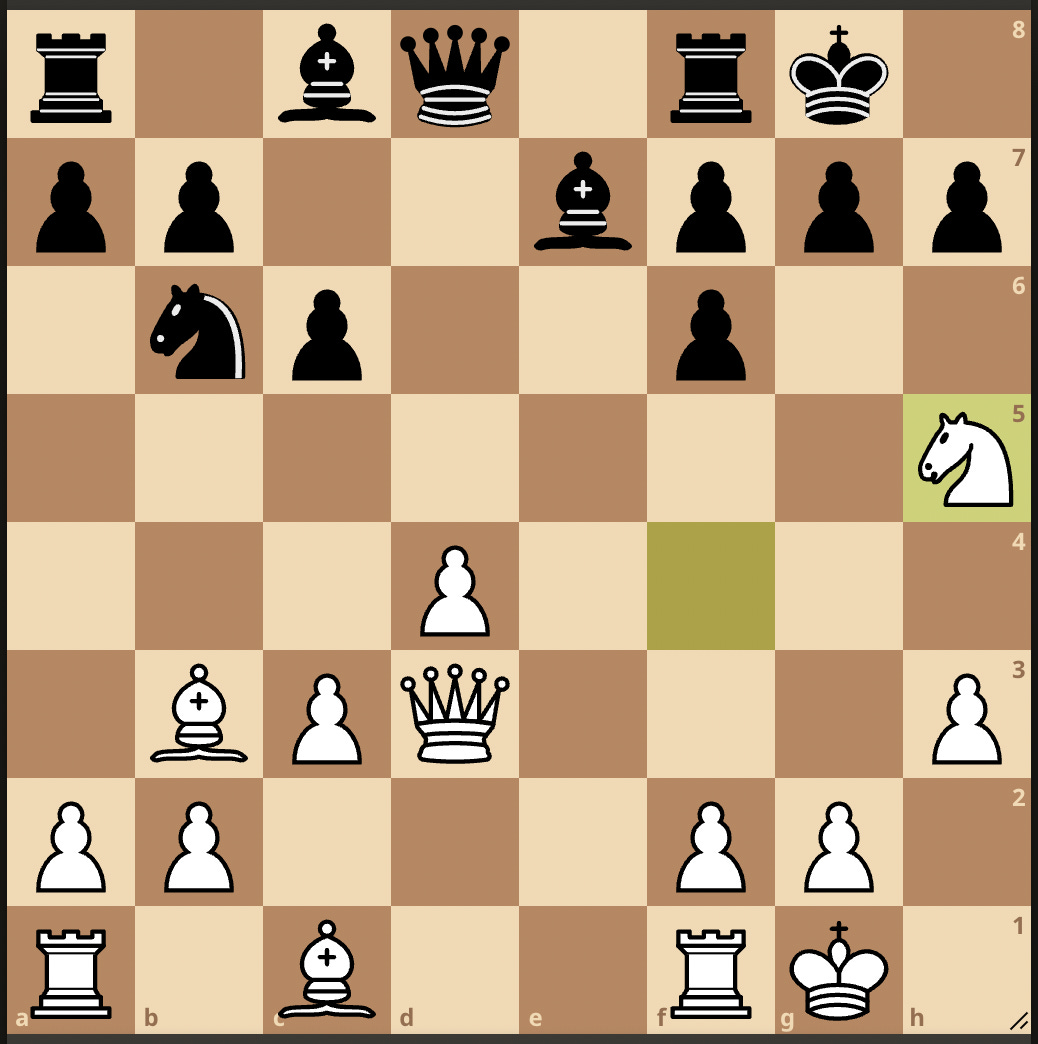
14...g6 ...and he played it.
15.Bh6! Now, black can not take the knight on h5 due to my threat of Qg3+ followed by mate on g7.
15...Re8 16.Nf4!? Preparing a knight sac next on g6! If black takes the sac I have Qxg6 followed by mate.
16...Bf5 17.Qf3 Bd6 18.Rfe1 Stopping his idea of Be4.
18...Qc7 19.Nh5 Same knight trying to enter again but Black knows he can not take as after Qxf5 the position is crushing for white as Bc2 is coming.
19...Nd7 20.Ng7
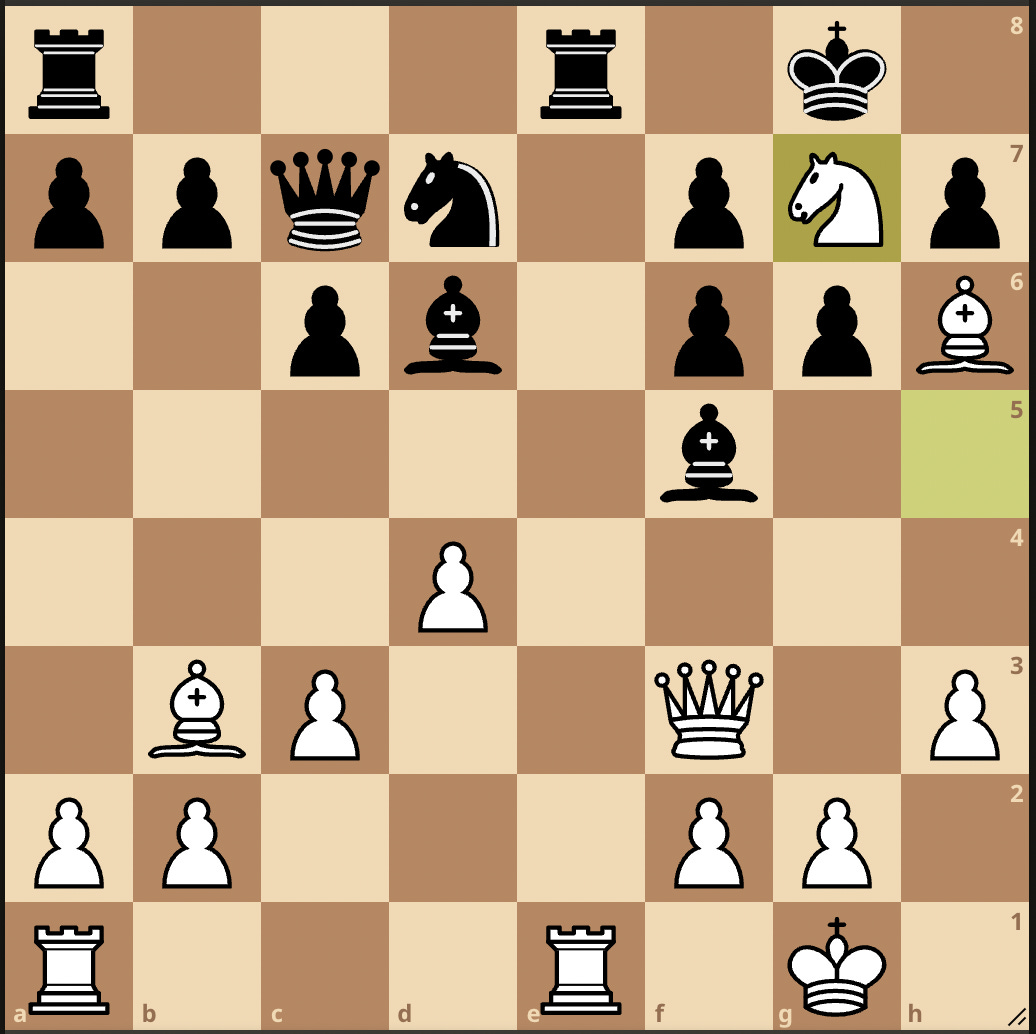
Maybe the most bizarre looking move I’ve ever played but this simply felt right, after tripling up black’s pawns on the f-file his king simply looks indefensible.
20...Rxe1+ 21.Rxe1 Bf8 22.Nxf5 gxf5 23.Bf4 Qd8 24.Qh5!
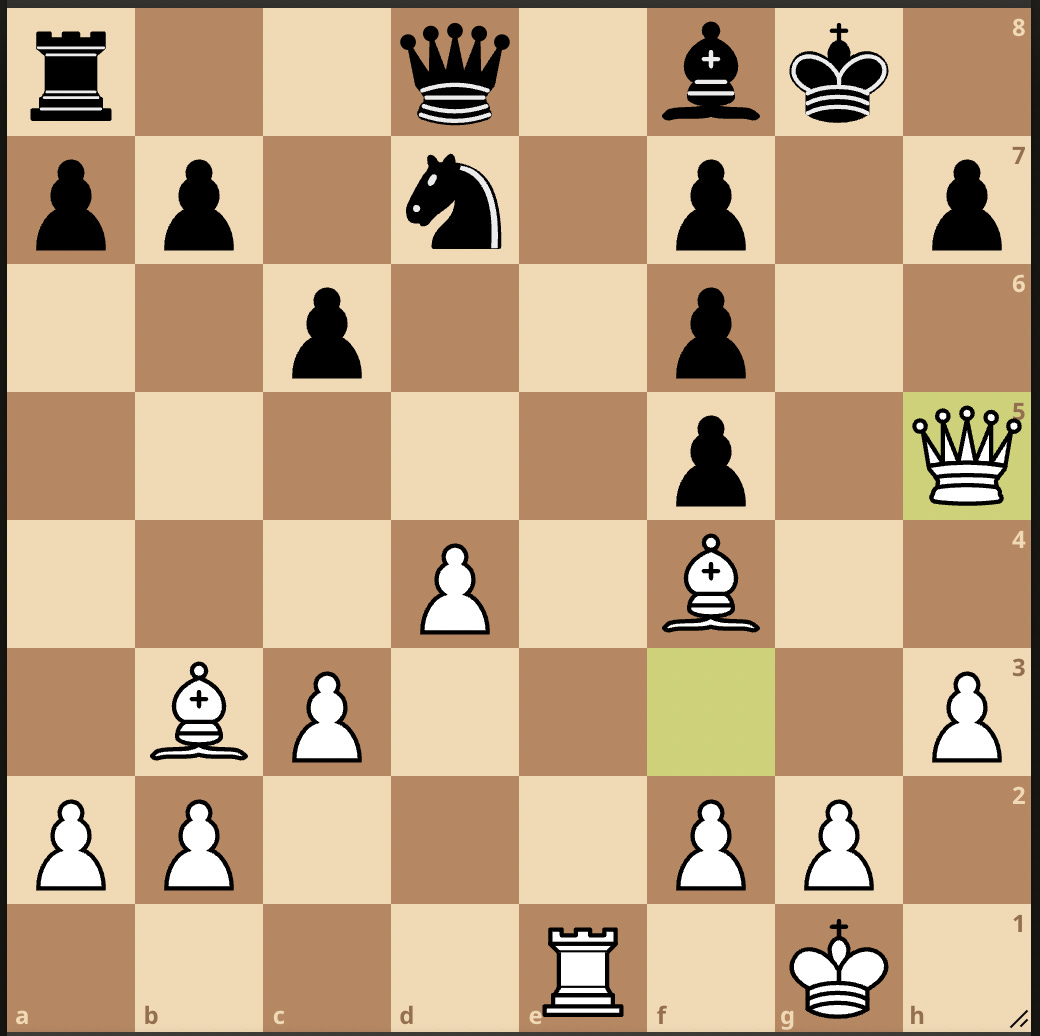
Here after 25.Kh8 Qxf7 I have threats of mate on g8, if Bg7 then Re7 and I’ll either mate him or win the knight. Black resigns. 1–0
What about yourself would you like other members to know, that we may not know! Any surprising facts?
I’m a pretty avid poker player, for the last 20 years. Which is probably not surprising since I honestly believe poker players and chess players have brains that are hard-wired the same way. You’ll find many professionals of one game that also play the other game. So outside of my day job, if I am not at the Marshall your best bet in finding me is at one of Atlantic City’s poker rooms. Currently, my single inspiration in trying to play more chess again is my children. During the pandemic’s lockdown I (as most others) stepped back from rated games and never got back into the swing of things. But recently as I’m seeing the interest and success of my children in scholastic tournaments, I’m inspired to start playing again. Coincidentally, I was just informed by US Chess that my daughter Dena (current reigning US Under 8 All-Girls Champion) will be in the November issue of Chess Life magazine.
Thanks to all regulars at Marshall for remembering me and to Ken Kubo for convincing me to do this interview.
— George Wang, Marshall Chess Club Member
Chess Toons
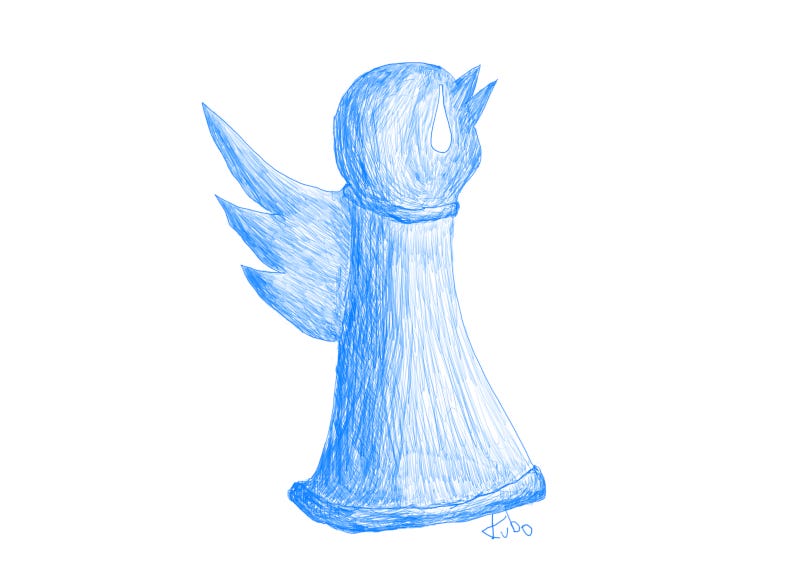
En Passant
– GM Hikaru Nakamura was crowned as the FIDE Fischer Random World Champion on Sunday after winning a thrilling armageddon tiebreaker against GM Ian Nepomniachtchi.
– From 19 to 26 November, the World Team Championship will be held in Jerusalem in a new format. Twelve national teams are taking part. The US team is led by Hans Niemann.
– The World Junior Championships took place in Cala Gonone, Italy Wednesday 12th to Sunday 23rd October 2022. This was the 59th edition and 38th Girls. The event hadn't been held since 2019 due to Covid-19.
– The Mechanic's Institute Newsletter features games, puzzles, news and analysis. FM Paul Whitehead's column in particular is a favorite of our Board.
Problem of the Week
A. A. Troitzky, 1895
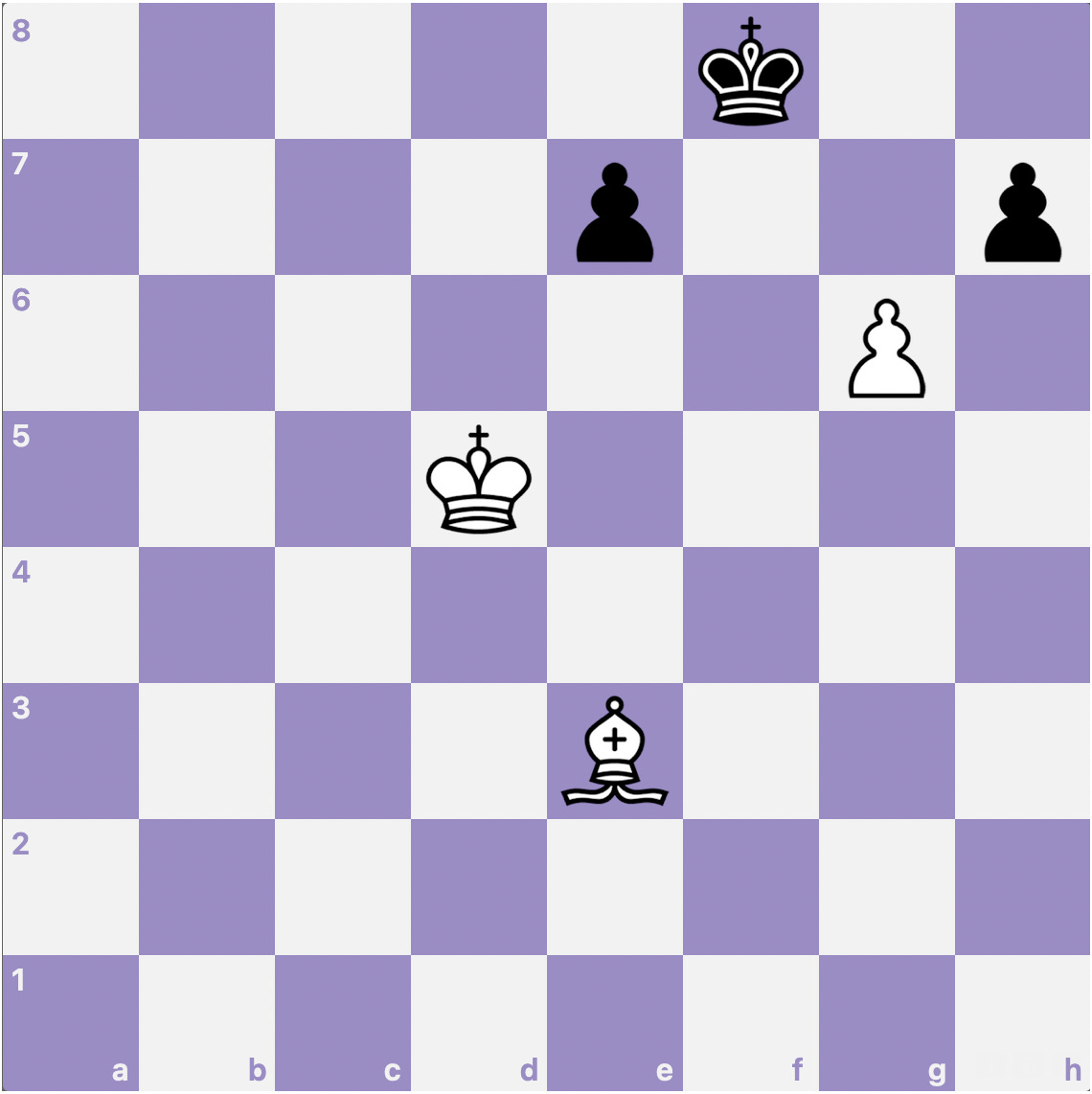
White to move and win
From the same year as last week's problem, another gem from a master of endgame composition. This is an exercise in optimism. It doesn't look easy for White, especially with Black's threats of stalemate.
---
Last week's problem: Saavedra, 1895:
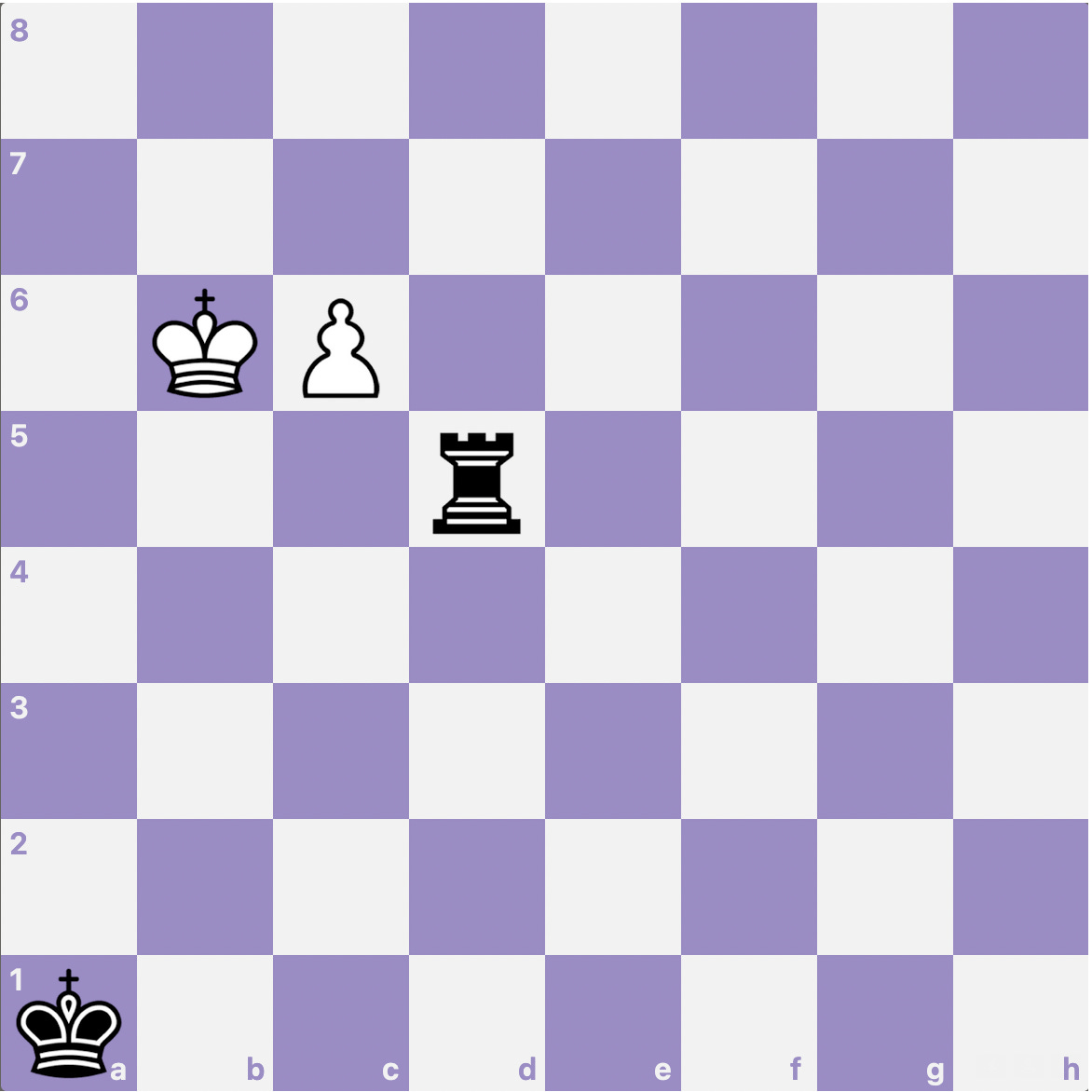
Solution to Saavedra, 1895: 1.c7 Rd6+ 2.Kb5 (anything else draws!) Rd5+ 3.Kb4 Rd4+ 4.Kb3 Rd3+ 5.Kc2 ... and now it looks like Black is done for. But no: 5...Rd4! and boom: 6.c8=Q Rc4+ 7.QxR stalemate. So instead, 6.c8=R!! Ra4 (forced to stop the mate) and now for a final double threat that seals the deal: 7.Kb3.
—Alexander George, Marshall Chess Club Member
Editor's Note
As always, if you have any feedback, comments, or would like to submit an article please contact us directly at td@marshallchessclub.org.
Enjoy, and thanks for reading!
The Marshall Chess Club
Address: 23 West Tenth Street New York, NY 10011
Contact: 212.477.3716; td@marshallchessclub.org
Hours: M-F 1pm-Midnight; Sat/Sun 9am-Midnight





